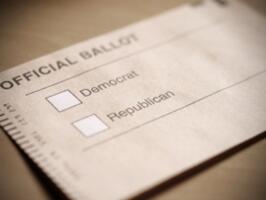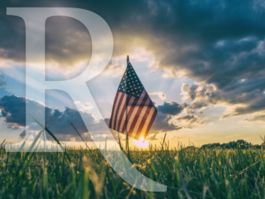What They Told Us: Reviewing Last Week’s Key Polls: Week of August 30
We’re off to the races. In nine weeks, America will elect a new Congress. Will it be more of the same, or will there be a new sheriff in town?
Republicans are highly unlikely to lose their control of the House of Representatives, and if the GOP makes a net gain of six seats, it will take charge of the Senate, too. Twenty-one of the 36 Senate seats up for grabs this November are held by Democrats, so President Obama’s party is clearly at greater risk.
Here’s where we stand right now in the Rasmussen Reports 2014 Senate Balance of Power rankings. Twenty of the 36 seats are out of play entirely, with 14 Safe Republican and six Safe Democrat. If these numbers hold through Election Day, the GOP is guaranteed to pick up three of the six it needs in Montana, South Dakota and West Virginia.
Three states – Georgia, Kentucky and North Carolina – are leaning the Republicans’ way, but only North Carolina is now held by a Democratic senator. Two – Michigan and Minnesota – are leaning toward reelecting their Democratic incumbents.
Six states are Toss-Ups – Alaska, Arkansas, Colorado, Iowa, Kansas and Louisiana. All but Kansas are now held by Democrats.
New Hampshire is a wild card: We’re waiting for its September 9 GOP primary before measuring where that race stands.
In short, if the Republicans hold onto all their existing Senate seats and pick up the three states that appear to be safe, they need three more wins to control the entire Congress.
Thirty-six states are having governor’s races this year, and here’s where the Rasmussen Reports 2014 Gubernatorial Scorecard stands.
Nine governorships are Safe Republican, five Safe Democrat, with the only likely turnover being Pennsylvania going Democrat. We looked at three of those races this week – Alaska, South Carolina and Vermont.
Six governor’s races are leaning Republican, including two now held by Democrats, Connecticut and Illinois. Minnesota is leaning toward reelecting Democrat Mark Dayton.
Eight states are Toss-ups – Arkansas, Colorado, Florida, Georgia, Maine, Michigan, New Mexico and Wisconsin. All but Arkansas and Colorado are now held by Republicans.
We still have several governor’s races to poll after their September 9 primaries finalize the match-ups.
Republicans have edged ahead of Democrats again on the latest Generic Congressional Ballot. But the two parties have been separated by two points or less for most weeks this year.
House Speaker John Boehner remains Congress’ most unpopular leader, but House Democratic leader Nancy Pelosi, his predecessor as speaker, is right on his heels.
The president’s daily job approval rating has been hovering around -20 for much of the summer.
Just 23% of voters think the country is heading in the right direction. Sixty-nine percent (69%) now think the country is headed down the wrong track.
Consumer and investor confidence are up from post-meltdown levels but haven’t moved much over the past couple years.
Some things haven’t changed in surveys for a long time. The national health care law, for one thing, remains unpopular, and the number of voters who say their insurance coverage has changed because of it is at its highest level in well over a year.
Most voters have told us for years that they favor spending cuts in every program of the federal government, but they now think it’s less likely than ever that government spending will be cut anytime soon.
The police shooting and subsequent events in Ferguson, Missouri also have raised concerns other than ones about race. Voters have long been skeptical of the federal government, but now most believe the nation’s chief law enforcer, the U.S. Department of Justice, is more interested in politics than in serving justice.
Americans also doubt that the media is playing it straight in its Ferguson coverage.
Voters see a pretty grim picture abroad, too. Five years ago this summer, the president gave a highly-publicized speech in Cairo, Egypt reaching out to Muslims, but 46% now believe our relations with the Islamic world are worse than they were at that time. Forty-four percent (44%) think U.S. policies are to blame.
But Americans also recognize that religious tolerance is a one-way street when it comes to the Muslim world.
They’re pretty angry, too, about the beheading of U.S. journalist James Foley on a video posted online and strongly believe his killer should be brought to justice and sentenced to death.
In other surveys last week:
-- Americans overwhelmingly count on their local water supply, but they're not nearly as confident that it's well protected.
-- Most voters continue to consider global warming a serious problem but remain unwilling to pay much to do anything about it.
-- Fifty-one percent (51%) of Americans expect higher interest rates next year. Americans also continue to wonder if the Federal Reserve Board has the ability to keep interest rates down and inflation under control.
-- Many students around the country are already returning to school, but Americans still prefer waiting until after Labor Day before sending them back.
-- Most Americans like the idea of sales tax holidays especially just before school starts and say they are more likely to buy things during such periods.
-- Americans think the “ice bucket challenge” has raised awareness and funds for Amyotrophic lateral sclerosis, also known as Lou Gehrig’s disease.
-- More Americans said they would take a vacation this summer, and it looks like they did.
Subscribers to Rasmussen Reports receive more than 20 exclusive stories each week for less than a dollar a week. Please sign up now. Visit the Rasmussen Reports home page for the latest current polling coverage of events in the news. The page is updated several times each day.
Remember, if it's in the news, it's in our polls.
Rasmussen Reports is a media company specializing in the collection, publication and distribution of public opinion information.
We conduct public opinion polls on a variety of topics to inform our audience on events in the news and other topics of interest. To ensure editorial control and independence, we pay for the polls ourselves and generate revenue through the sale of subscriptions, sponsorships, and advertising. Nightly polling on politics, business and lifestyle topics provides the content to update the Rasmussen Reports web site many times each day. If it's in the news, it's in our polls. Additionally, the data drives a daily update newsletter and various media outlets across the country.
Some information, including the Rasmussen Reports daily Presidential Tracking Poll and commentaries are available for free to the general public. Subscriptions are available for $4.95 a month or 34.95 a year that provide subscribers with exclusive access to more than 20 stories per week on upcoming elections, consumer confidence, and issues that affect us all. For those who are really into the numbers, Platinum Members can review demographic crosstabs and a full history of our data.
To learn more about our methodology, click here.



